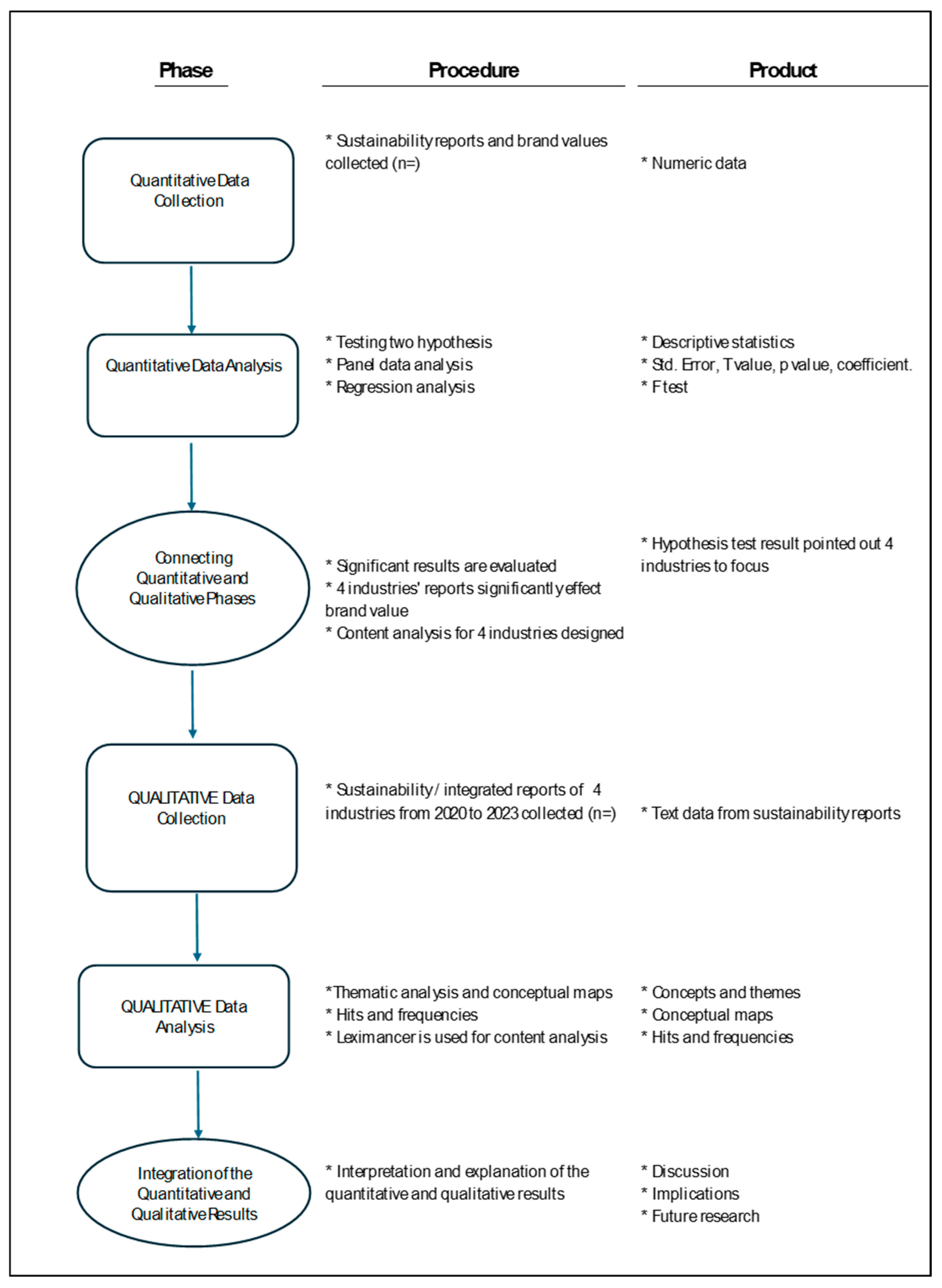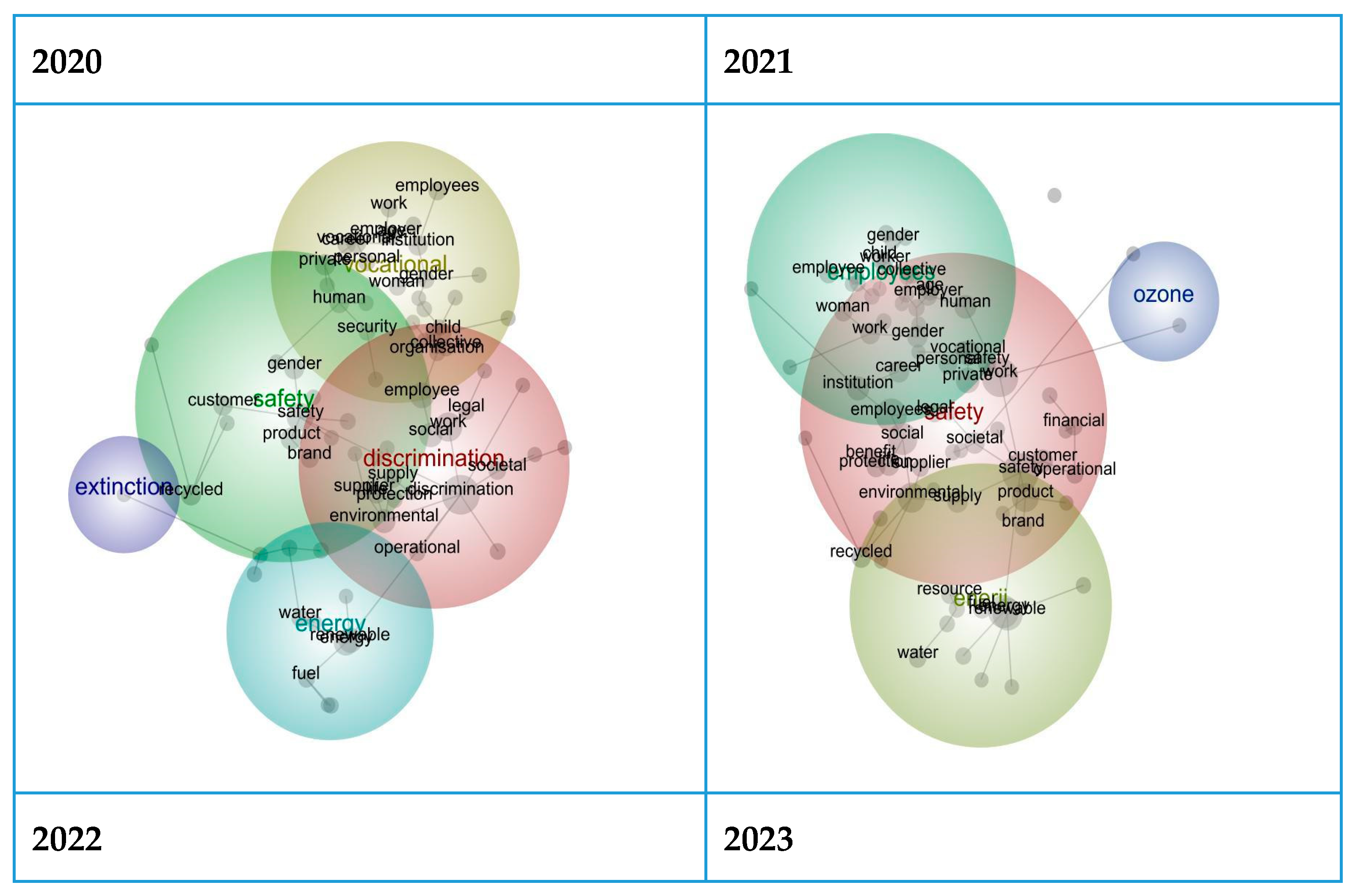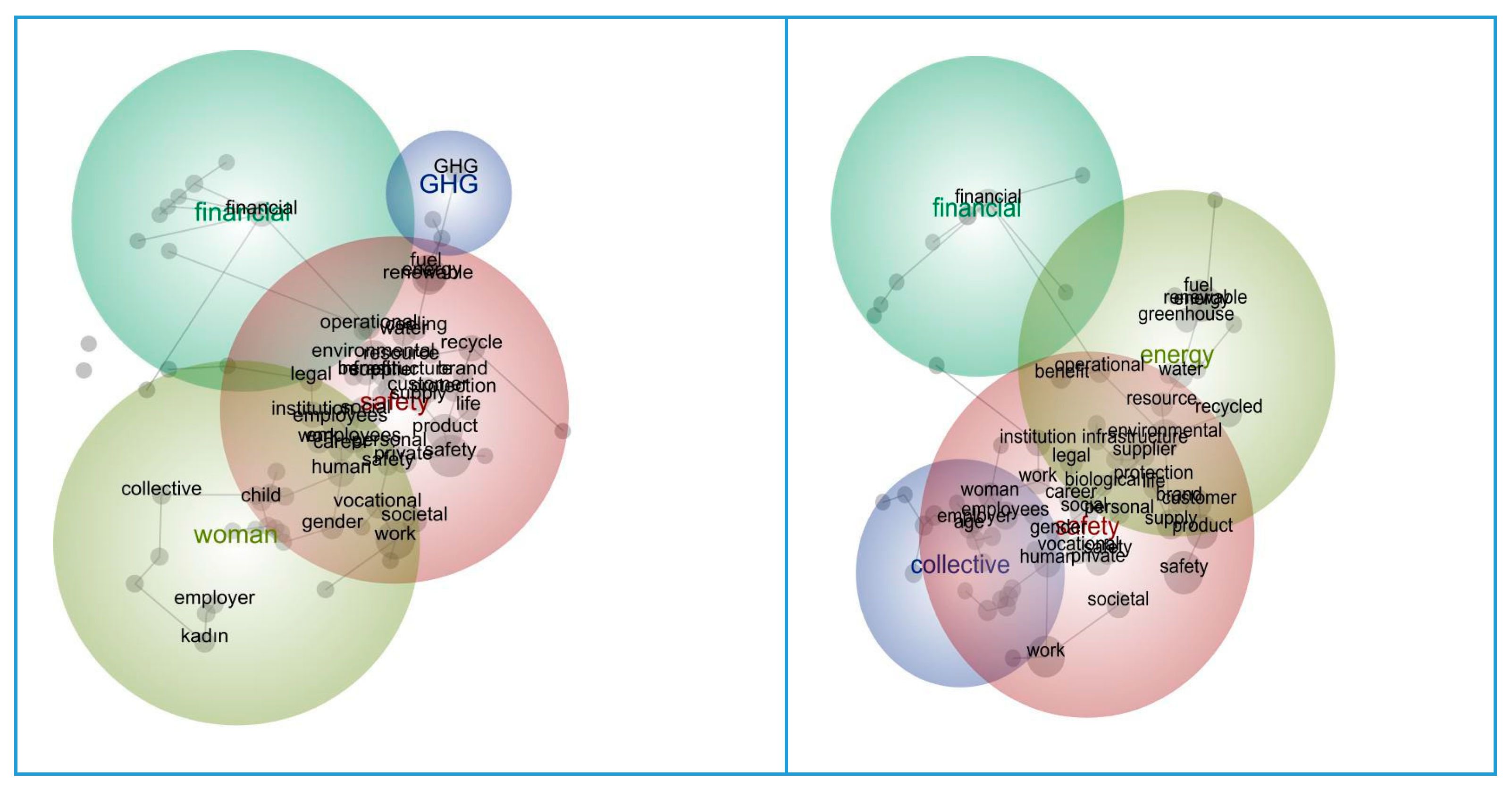Corporate Sustainability Reporting and Its Influence on Brand Value: A Sectoral Analysis of Top Brands in an Emerging Market
Abstract
1. Introduction
2. Literature Review and Hypothesis Development
2.1. Brand Equity and Value Drivers
2.2. Corporate Social Responsibility, Sustainability, and Brand Value
2.3. Sustainability Reporting and Its Link to Brand and Firm Value
2.4. Brand Valuation Methods and Relevance to This Study
- Step 1.
- Calculate Brand Strength (Brand Strength Index—BSI): Brand strength is assessed on a 0–100 scale using a balanced scorecard of attributes such as familiarity, emotional appeal, consideration, reputation, and loyalty.
- Step 2.
- Determine the Royalty Rate Range: An appropriate royalty rate range for the brand’s sector is identified by analyzing comparable licensing agreements from Brand Finance’s proprietary database and other public sources.
- Step 3.
- Calculate the Royalty Rate: The BSI score is mapped onto the royalty rate range to establish a specific royalty rate.
- Step 4.
- Estimate Brand-Specific Revenues: A portion of the parent company’s total revenues is attributed to the specific brand and its industry sector, isolating brand-generated income.
- Step 5.
- Forecast Future Brand Revenues: Brand-specific revenues are projected using historical performance data, equity analyst forecasts, and macroeconomic growth indicators.
- Step 6.
- Apply the Royalty Rate: The forecasted brand revenues are multiplied by the determined royalty rate to calculate the implied royalty payments for brand usage.
- Step 7.
- Discount to Present Value: The projected post-tax royalty streams are discounted to their net present value (NPV) using an appropriate discount rate.
2.5. Summary and Research Gap
2.6. Theoretical Framework Linking Sustainability Reporting to Brand Value
3. Methodology
- RQ1: Is there a relationship between the company’s brand value and the sustainability reporting?
- RQ2: If yes, how does this relationship vary by sector?
- RQ3: How has the thematic content of reports evolved in key sectors?
4. Results
4.1. Quantitative Research (Phase 1)
β5 (SRi,t × Sector Dummyi) + ui + ϵit
4.2. Qualitative Research (Phase 2)
5. Discussion
5.1. Quantitative Insights
5.2. Qualitative Insights from Sectoral Content Analysis
5.3. Integration and Interpretation
6. Conclusions
Author Contributions
Funding
Data Availability Statement
Acknowledgments
Conflicts of Interest
References
- Doyle, P. Shareholder-value-based brand strategies. J. Brand Manag. 2001, 9, 20–30. [Google Scholar] [CrossRef]
- Ambler, T. Marketing and the Bottom Line; Pearson Education: London, UK, 2000. [Google Scholar]
- Brand Finance. 2022. Available online: https://brandirectory.com/reports/turkiye/2022 (accessed on 6 March 2024).
- Aaker, D. Managing Brand Equity: Capitalizing on The Value of a Brand Name; The Free Press: New York, NY, USA, 1991. [Google Scholar]
- Keller, K.L. Conceptualizing, measuring, and managing customer-based brand equity. J. Mark. 1993, 57, 1–22. [Google Scholar] [CrossRef]
- Keller, K.L.; Kotler, P. Holistic marketing: A broad, integrated perspective to marketing management. In Does Marketing Need Reform? Fresh Perspectives on the Future; Routledge: Abingdon, UK, 2015; pp. 308–313. [Google Scholar]
- Interbrand. Available online: https://interbrand.com (accessed on 6 March 2024).
- Brand Finance. 2023. Available online: https://static.brandirectory.com/reports/brand-finance-global-500-2023-preview.pdf (accessed on 6 March 2024).
- Presidency of the Republic of Türkiye. Directorate of Strategy and Budget. 2024. “On İkinci Kalkınma Planı (2024–2028)”. Available online: https://www.sbb.gov.tr/wp-content/uploads/2023/12/On-Ikinci-Kalkinma-Plani_2024-2028_11122023.pdf (accessed on 6 March 2024).
- Republic of Türkiye Ministry of Trade. 2024. “Yeşil Mutabakat”. Available online: https://ticaret.gov.tr/dis-iliskiler/yesil-mutabakat/genel-bilgi (accessed on 6 March 2024).
- Aksoy, M. Relationship between corporate sustainability performance and brand performance: Evidence from Borsa Istanbul. Res. J. Bus. Manag. 2019, 7, 139–148. [Google Scholar]
- Kotler, P.; Keller, K.L.; Chernev, A. Marketing Management, 16th ed.; Global Edition; Pearson: London, UK, 2022. [Google Scholar]
- Møller Jensen, J.; Hansen, T. An empirical examination of brand loyalty. J. Prod. Brand Manag. 2006, 15, 442–449. [Google Scholar] [CrossRef]
- Punniyamoorthy, M.; Prasanna Mohan Raj, M. An empirical model for brand loyalty measurement. J. Target. Meas. Anal. Mark. 2007, 15, 222–233. [Google Scholar] [CrossRef]
- Chaudhuri, A.; Holbrook, M.B. The chain of effects from brand trust and brand affect to brand performance: The role of brand loyalty. J. Mark. 2001, 65, 81–93. [Google Scholar] [CrossRef]
- Qiao, Y.; Yin, X.; Xing, G. Impact of perceived product value on customer-based brand equity: Marx’s theory–value-based perspective. Front. Psychol. 2022, 13, 931064. [Google Scholar] [CrossRef] [PubMed]
- Rahman, M.; Rodríguez-Serrano, M.Á.; Lambkin, M. Corporate social responsibility and marketing performance: The moderating role of advertising intensity. J. Advert. Res. 2017, 57, 368–378. [Google Scholar] [CrossRef]
- Harjoto, A.M.; Salas, J. Strategic and institutional sustainability: Corporate social responsibility, brand value, and Interbrand listing. J. Prod. Brand Manag. 2017, 26, 545–558. [Google Scholar] [CrossRef]
- Ajour El Zein, S.; Consolacion-Segura, C.; Huertas-Garcia, R. The role of sustainability in brand equity value in the financial sector. Sustainability 2019, 12, 254. [Google Scholar] [CrossRef]
- Servaes, H.; Tamayo, A. The impact of corporate social responsibility on firm value: The role of customer awareness. Manag. Sci. 2013, 59, 1045–1061. [Google Scholar] [CrossRef]
- Loh, L.; Tan, S. Impact of sustainability reporting on brand value: An examination of 100 leading brands in Singapore. Sustainability 2020, 12, 7392. [Google Scholar] [CrossRef]
- Taiwo, O.J.; Owowlabi, B.A.; Adedokun, Y.; Ogundajo, G. Sustainability reporting and market value growth of quoted companies in Nigeria. J. Financ. Report. Account. 2022, 20, 542–557. [Google Scholar] [CrossRef]
- Kinnunen, J.; Saunila, M.; Ukko, J.; Rantanen, H. Strategic sustainability in the construction industry: Impacts on sustainability performance and brand. J. Clean. Prod. 2022, 368, 133063. [Google Scholar] [CrossRef]
- Loh, L.; Thomas, T.; Wang, Y. Sustainability Reporting and Firm Value: Evidence from Singapore-Listed Companies. Sustainability 2017, 9, 2112. [Google Scholar] [CrossRef]
- Bachoo, K.; Tan, R.; Wilson, M. Firm value and the quality of sustainability reporting in Australia. Aust. Account. Rev. 2013, 23, 67–87. [Google Scholar] [CrossRef]
- Kuzey, C.; Uyar, A. Determinants of sustainability reporting and its impact on firm value: Evidence from the emerging market of Turkey. J. Clean. Prod. 2017, 143, 27–39. [Google Scholar] [CrossRef]
- Nguyen, D.T.T. An empirical study on the impact of sustainability reporting on firm value. J. Compet. 2020, 12, 119–135. [Google Scholar] [CrossRef]
- Yondrichs, M.; Laupe, S.; Mayapada, A.G.; Jurana, R. The effect of fundamental factors, sustainability reporting, and corporate governance on firm value. Univers. J. Account. Financ. 2021, 9, 1503–1509. [Google Scholar] [CrossRef]
- Suhartini, D.; Tjahjadi, B.; Fayanni, Y. Impact of sustainability reporting and governance on firm value: Insights from the Indonesian manufacturing sector. Cogent Bus. Manag. 2024, 11, 2381087. [Google Scholar] [CrossRef]
- Friske, W.; Hoelscher, S.A.; Nikolov, A.N. The impact of voluntary sustainability reporting on firm value: Insights from signaling theory. J. Acad. Mark. Sci. 2023, 51, 372–392. [Google Scholar] [CrossRef]
- Brand Finance. Brand Valuation Methodology. Available online: https://brandirectory.com/methodology (accessed on 1 March 2024).
- Interbrand Best Global Brands. Available online: https://interbrand.com/best-global-brands/ (accessed on 1 March 2024).
- Kantar. Available online: https://www.kantar.com/campaigns/brandz/global (accessed on 5 September 2025).
- Bagna, E.; Dicuonzo, G.; Perrone, A.; Dell’Atti, V. The value relevance of brand valuation. Appl. Econ. 2017, 49, 5865–5876. [Google Scholar] [CrossRef]
- Bebbington, J.; Larrinaga, C.; Moneva, J.M. Corporate social reporting and reputation risk management. Account. Audit. Account. J. 2008, 21, 337–361. [Google Scholar] [CrossRef]
- O’donovan, G. Environmental disclosures in the annual report: Extending the applicability and predictive power of legitimacy theory. Account. Audit. Account. J. 2002, 15, 344–371. [Google Scholar] [CrossRef]
- Aguilera, R.V.; Rupp, D.E.; Williams, C.A.; Ganapathi, J. Putting the S back in corporate social responsibility: A multilevel theory of social change in organizations. Acad. Manag. Rev. 2007, 32, 836–863. [Google Scholar] [CrossRef]
- Freeman, R.E. Strategic Management: A Stakeholder Approach; Cambridge University Press: Cambridge, UK, 2010. [Google Scholar]
- Kochkina, N.; Macchia, S.; Floris, M. Strategic Language Use in Sustainability Reporting: An Empirical Study. Sustainability 2024, 16, 10229. [Google Scholar] [CrossRef]
- Suchman, M.C. Managing legitimacy: Strategic and institutional approaches. Acad. Manag. Rev. 1995, 20, 571–610. [Google Scholar] [CrossRef]
- Tregidga, H.; Milne, M.J. From sustainable management to sustainable development: A longitudinal analysis of a leading New Zealand environmental reporter. Bus. Strategy Environ. 2006, 15, 219–241. [Google Scholar] [CrossRef]
- Crane, A.; Glozer, S. Researching corporate social responsibility communication: Themes, opportunities and challenges. J. Manag. Stud. 2016, 53, 1223–1252. [Google Scholar] [CrossRef]
- Birth, G.; Illia, L.; Lurati, F.; Zamparini, A. Communicating CSR: Practices among Switzerland’s top 300 companies. Corp. Commun. Int. J. 2008, 13, 182–196. [Google Scholar] [CrossRef]
- KGK Raporlama Standartları. Available online: https://www.kgk.gov.tr/SustainabilityDetailForm/11455/surdurulebilirlik-yayinlar. (accessed on 1 November 2025).
- Brand Finance. Available online: https://brandfinance.com/offices/turkey (accessed on 1 March 2024).
- Creswell, J.W.; Creswell, J.D. Research Design: Qualitative, Quantitative, and Mixed Methods Approaches; Sage Publications: Thousand Oaks, CA, USA, 2017. [Google Scholar]
- Ivankova, N.V.; Creswell, J.W.; Stick, S.L. Using mixed-methods sequential explanatory design: From theory to practice. Field Methods 2006, 18, 3–20. [Google Scholar] [CrossRef]
- Brammer, S.; Millington, A. Firm size, organizational visibility and corporate philanthropy: An empirical analysis. Bus. Ethics A Eur. Rev. 2006, 15, 6–18. [Google Scholar] [CrossRef]
- Wang, M.C. The relationship between firm characteristics and the disclosure of sustainability reporting. Sustainability 2017, 9, 624. [Google Scholar] [CrossRef]
- Alghamdi, O.A.; Agag, G. Unlocking the Power of Reporting: Exploring the Link between Voluntary Sustainability Reporting, Customer Behavior, and Firm Value. Sustainability 2023, 15, 15584. [Google Scholar] [CrossRef]
- Stemler, S. An overview of content analysis. Pract. Assess. Res. Eval. 2000, 7, 17. [Google Scholar]
- Brglez, K.; Perc, M.; Lukman, R.K. The complexity and interconnectedness of circular cities and the circular economy for sustainability. Sustain. Dev. 2023, 32, 2049–2065. [Google Scholar] [CrossRef]
- Leximancer. Available online: https://www.leximancer.com/resources (accessed on 5 March 2024).
- Tunca, S.; Sezen, B.; Wilk, V. An exploratory content and sentiment analysis of the guardian metaverse articles using Leximancer and natural language processing. J. Big Data 2023, 10, 82. [Google Scholar] [CrossRef]







| Report Type | Independent Assurance Report on Sustainability Disclosures | Total | |
|---|---|---|---|
| Yes | No | ||
| Sustainability Report | 49 | 97 | 146 |
| Integrated Report | 43 | 22 | 65 |
| Non-reporting | - | - | 92 |
| Total Firm-Years | 92 | 119 | 303 |
| Firms with Available Data | Initial Sample Size | |
|---|---|---|
| S1—Information and Communication/ Telecommunications | 7 | 9 |
| S2—Education, Health, Sports, and Entertainment Services | 0 | 4 |
| S3—Manufacturing | 30 | 34 |
| S4—Construction and Public Works | 3 | 3 |
| S5—Logistics | 1 | 3 |
| S6—Financial Institutions | 20 | 22 |
| S7—Healthcare | 1 | 1 |
| S8—Technology | 1 | 3 |
| S9—Wholesale and Retail Trade | 14 | 16 |
| S10—Transportation and Storage | 4 | 5 |
| Total | 81 | 100 |
| Statistics | Brand Value | Leverage | LogAssets |
|---|---|---|---|
| Mean | 227.58 | 1.67 | 4.39 |
| Median | 66.00 | 1.41 | 4.37 |
| Standard Deviation | 361.23 | 0.98 | 0.91 |
| Min | 6.00 | 0.0021 | 1.53 |
| Max | 2000.00 | 11.90 | 6.63 |
| Variables | Brand Value | SR | AR | LogAssets | Leverage |
|---|---|---|---|---|---|
| Brand Value | 1.000 | ||||
| SR | 0.281 *** | 1.000 | |||
| AR | 0.265 *** | 0.436 *** | 1.000 | ||
| LogAssets | 0.493 *** | 0.380 *** | 0.488 *** | 1.000 | |
| Leverage | −0.150 ** | −0.064 | −0.095 | −0.212 *** | 1.000 |
| Variables | Brand Value | SR | AR | Leverage | LogAssets |
|---|---|---|---|---|---|
| Brand Value | 1.000 | ||||
| SR | 0.462 *** | 1.000 | |||
| AR | 0.401 *** | 0.436 *** | 1.000 | ||
| Leverage | −0.157 ** | −0.039 | −0.132 * | 1.000 | |
| LogAssets | 0.585 *** | 0.408 *** | 0.484 *** | −0.361 *** | 1.000 |
| Independent Variables | Coef. | Std. Err. | t-Statistics | p > t |
|---|---|---|---|---|
| SR | −392.6962 | 132.1025 | −2.97 | 0.003 |
| AR | −61.60175 | 35.07876 | −1.76 | 0.081 |
| Leverage | 6.989786 | 11.06266 | 0.63 | 0.528 |
| LogAssets | −97.4897 | 21.53358 | −4.53 | 0.000 |
| Sector Dummy 9 | −7.9969 | 123.9595 | −0.06 | 0.949 |
| SR × Sector Dummy 1 | 238.3936 | 163.9743 | 1.45 | 0.147 |
| SR × Sector Dummy 3 | 477.6127 | 143.2284 | 3.33 | 0.001 |
| SR × Sector Dummy 4 | 406.375 | 190.8864 | 2.13 | 0.034 |
| SR × Sector Dummy 6 | 411.7703 | 119.8088 | 3.44 | 0.001 |
| SR × Sector Dummy 9 | 474.947 | 146.3591 | 3.25 | 0.001 |
| Constant | 658.02 | 95.17367 | 6.91 | 0.000 |
| Phase | Procedure | Description/Criteria |
|---|---|---|
| Inclusion Criteria of Sustainability Reports | Data Source | Sustainability or integrated reports publicly disclosed by brands listed in the annual Top 100 Most Valuable Brands in Türkiye ranking compiled by BrandFinance, an independent brand valuation organization. |
| Time Frame | Reports published between 2020 and 2023 to ensure temporal comparability. | |
| Eligibility Criteria | (i) Available in full text; (ii) issued directly by the corporation (excluding subsidiaries or third-party summaries); (iii) explicitly structured according to sustainability, ESG, or integrated reporting frameworks. | |
| Preprocessing for Leximancer | Language and Format | All reports were originally in Turkish |
| Cleaning | Removal of conjunctions, prepositions, and function words (e.g., ‘and’, ‘not’). | |
| Semantic Normalization | Merging of singular/plural and morphological variants (e.g., ‘product/products’, ‘work/works’). | |
| Stop-word Refinement | Exclusion of generic, low-information terms (e.g., ‘importance’, ‘year’, ‘concrete’). | |
| Concept Alignment | Development of user-defined concepts based on Global Reporting Initiative (GRI) topic structure to ensure international consistency. | |
| Parameter Settings | Concept visibility: 33%; theme size: 60% (to balance comprehensiveness and interpretability). | |
| Post-processing | Concept labels were translated into English for cross-sectoral comparison and interpretation. |
Disclaimer/Publisher’s Note: The statements, opinions and data contained in all publications are solely those of the individual author(s) and contributor(s) and not of MDPI and/or the editor(s). MDPI and/or the editor(s) disclaim responsibility for any injury to people or property resulting from any ideas, methods, instructions or products referred to in the content. |
© 2025 by the authors. Licensee MDPI, Basel, Switzerland. This article is an open access article distributed under the terms and conditions of the Creative Commons Attribution (CC BY) license (https://creativecommons.org/licenses/by/4.0/).
Share and Cite
Adıgüzel, H.; Ergen, A. Corporate Sustainability Reporting and Its Influence on Brand Value: A Sectoral Analysis of Top Brands in an Emerging Market. Sustainability 2025, 17, 10108. https://doi.org/10.3390/su172210108
Adıgüzel H, Ergen A. Corporate Sustainability Reporting and Its Influence on Brand Value: A Sectoral Analysis of Top Brands in an Emerging Market. Sustainability. 2025; 17(22):10108. https://doi.org/10.3390/su172210108
Chicago/Turabian StyleAdıgüzel, Hümeyra, and Ahu Ergen. 2025. "Corporate Sustainability Reporting and Its Influence on Brand Value: A Sectoral Analysis of Top Brands in an Emerging Market" Sustainability 17, no. 22: 10108. https://doi.org/10.3390/su172210108
APA StyleAdıgüzel, H., & Ergen, A. (2025). Corporate Sustainability Reporting and Its Influence on Brand Value: A Sectoral Analysis of Top Brands in an Emerging Market. Sustainability, 17(22), 10108. https://doi.org/10.3390/su172210108







